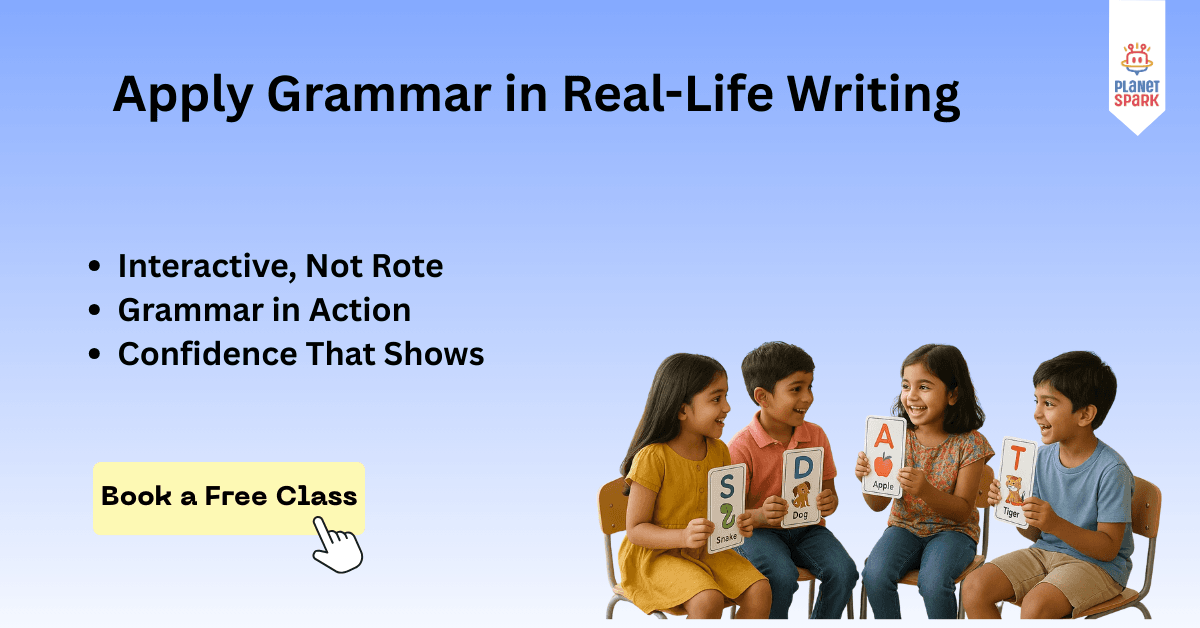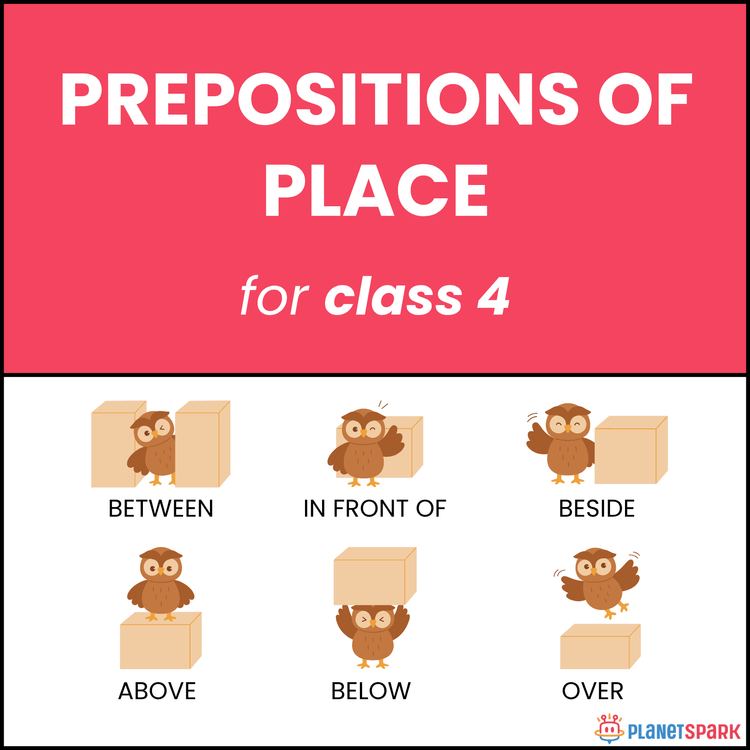Prepositions of Movement: Meaning, Examples, Worksheets & Tips

Table of Contents
- What are Prepositions of Movement?
- Extended List of Prepositions of Movement with Examples
- Categories of Prepositions of Movement
- Prepositions of Movement in Storytelling
- Common Mistakes with Prepositions of Movement
- Prepositions of Movement vs. Prepositions of Direction
- Prepositions of Place and Movement Compared
- Preposition of Movement Examples in Daily Life
- Preposition of Movement Worksheets
- Prepositions of Movement Exercises
- Fun Activities for Kids to Learn Prepositions of Movement
- Prepositions of Movement in Spoken English
- Advanced Usage: Idiomatic Expressions
- Learn English Grammar with PlanetSpark
- Frequently Asked Questions (FAQs)
When you speak or write in English, it’s not enough to only describe where something is. You often need to explain how it moves from one place to another. That’s where prepositions of movement become important.
For example:
Saying “The ball is on the table” tells position.
Saying “The ball rolled onto the table” describes movement.
This small shift in words makes your sentence more vivid and accurate. That’s why mastering prepositions of movement and direction is essential for learners of all ages.
What are Prepositions of Movement?
A preposition of movement is a grammar tool that shows the direction, path, or destination of an action. Unlike static prepositions of place, these indicate action in progress or change in position.
Prepositions of place: “The boy is in the room.”
Prepositions of movement: “The boy walked into the room.”
So the difference lies in the motion implied by the preposition.

Extended List of Prepositions of Movement with Examples
Here’s a comprehensive list of prepositions of movement you’ll often use:
Into
She went into the house.
He threw the ball into the basket.
Onto
He climbed onto the roof.
The child jumped onto the sofa.
To
We are going to the library.
He delivered the letter to her.
Book Your Free Trial Class Today and see how fun grammar learning can be.
Toward / Towards
She walked toward the bus stop.
He ran towards the playground.
Through
The train went through the tunnel.
Light passes through the glass.
Across
He ran across the road.
She swam across the pool.
Over
The cat jumped over the wall.
The plane flew over the city.
Under
The boy crawled under the table.
The river flows under the bridge.
Along
They strolled along the beach.
The car drove along the highway.
Up / Down
She climbed up the mountain.
He ran down the stairs.
Around
The dog ran around the yard.
The car drove around the corner.
Onto vs. On (Key Difference)
Place: “The book is on the desk.”
Movement: “She put the book onto the desk.”
Sign Up Now to unlock interactive English grammar lessons with expert teachers.
Categories of Prepositions of Movement
To make it clearer, let’s divide prepositions of movement into categories:
Prepositions showing direction toward a place
To, Towards, Into, Onto
Prepositions showing movement through a place
Across, Through, Along
Prepositions showing movement over/under something
Over, Under, Down, Up
Prepositions showing circular or surrounding movement
Around, Past, Along
Prepositions of Movement in Storytelling
Writers often use prepositions of movement to make their descriptions dynamic. Compare these two short passages:
Without prepositions of movement:
The boy was in the park. The dog was by the bench.With prepositions of movement:
The boy ran across the park while the dog jumped onto the bench.
See how the second version feels more alive? That’s the power of these prepositions.

Common Mistakes with Prepositions of Movement
Students often confuse prepositions of movement with place prepositions. Here are a few common errors:
❌ He is going in the bus.
✅ He is going onto the bus.
❌ She walked in the classroom.
✅ She walked into the classroom.
❌ The cat jumped in the table.
✅ The cat jumped onto the table.
Prepositions of Movement vs. Prepositions of Direction
While both are close, here’s the distinction:
Prepositions of movement = show the action of moving (into, onto, across).
Prepositions of direction = show the aim or destination of the movement (to, towards).
Example:
She is going to the park. (direction)
She ran into the park. (movement)
Prepositions of Place and Movement Compared
Here’s a quick table to simplify learning:
| Preposition | Place Example | Movement Example |
|---|---|---|
| In | The toys are in the box. | He put the toys into the box. |
| On | The keys are on the table. | She jumped onto the table. |
| Under | The bag is under the chair. | The dog crawled under the chair. |
| Over | The lamp hangs over the sofa. | The bird flew over the house. |
| At → To | She is at the station. | She went to the station. |
Preposition of Movement Examples in Daily Life
To reinforce learning, here are 10 daily-life examples:
The teacher walked into the classroom.
The children ran across the playground.
The airplane flew over the mountains.
The boy slid down the slide.
The bus went through the tunnel.
The kids climbed up the tree.
The ball rolled into the corner.
The puppy ran around the garden.
The family walked along the river.
The crowd moved towards the stadium.
Preposition of Movement Worksheets
Practice is the key to mastering grammar. Try these worksheets:
Worksheet 1: Fill in the blanks
The cat jumped ___ the chair.
They walked ___ the road.
He went ___ the tunnel.
The ball rolled ___ the floor.
(Answers: onto, across, through, along)
Worksheet 2: Correct the mistake
❌ The bird flew in the house.
✅ The bird flew into the house.
❌ He climbed in the bus.
✅ He climbed onto the bus.
Worksheet 3: Choose the correct preposition
She ran (into/on) the room.
He walked (towards/onto) the park.
The ball went (over/at) the fence.
Start Learning with PlanetSpark, where grammar meets fun, creativity, and confidence.
Prepositions of Movement Exercises
Test your skills with these exercises:
Write five sentences using into and onto.
Describe your walk to school using at least five different prepositions of movement.
Rewrite this sentence with a movement preposition:
He is in the room. → He went into the room.
Fun Activities for Kids to Learn Prepositions of Movement
Drawing activity: Kids draw arrows to show movement across, into, onto objects.
Role play: Act out sentences like “Jump onto the chair” or “Run across the room.”
Story writing: Ask children to write a short story using at least 5 prepositions of movement.
Prepositions of Movement in Spoken English
In conversations, these prepositions make directions clear. For example:
“Go across the road and walk towards the bank.”
“Climb up the stairs and turn into the hallway.”
Using them naturally makes your spoken English more effective.
Advanced Usage: Idiomatic Expressions
Some idiomatic phrases also use prepositions of movement:
“Go over the details” (not physical, but metaphorical movement)
“Run through the notes”
“Walk into trouble”
This shows prepositions of movement can be used beyond physical motion.

Learn English Grammar with PlanetSpark
At PlanetSpark, we believe grammar should never feel like a boring set of rules. Instead, it should be simple, interactive, and engaging. Our English Grammar Course is designed to help children build a strong foundation in grammar while also learning how to use it in real-life communication.
Unlike traditional methods that rely only on memorization, PlanetSpark focuses on concept clarity, practice, and application. This ensures that learners not only know grammar rules but can also use them confidently in speaking and writing.
Features of PlanetSpark’s Grammar Course
Live Interactive Classes with Certified Teachers
Classes are conducted in real-time with expert teachers who simplify grammar concepts and make them easy to understand. Students can ask questions, interact, and get instant feedback.Fun Worksheets and Grammar Activities
Children learn better when they play, practice, and experiment. Our worksheets and activity-based exercises make learning grammar exciting rather than monotonous.Real-World Speaking Practice
Grammar is not just about writing correct sentences, it’s about speaking fluently too. Students practice using grammar naturally in conversations, role plays, and storytelling.Small Batches for Personalized Attention
Each child learns differently. That’s why we keep class sizes small, so every student gets the focus, guidance, and encouragement they need.Progress Tracking for Parents
Parents receive regular updates on their child’s performance, strengths, and areas of improvement, making learning a transparent journey.
Unique Benefits (USPs) of Learning with PlanetSpark
Contextual Learning Instead of Memorization
Kids don’t just memorize grammar rules — they learn to apply them while speaking, reading, and writing. This ensures long-term retention.Balanced Focus on Writing and Speaking
Our program develops both written accuracy and spoken fluency, giving learners complete confidence in using English.Engaging Methods with Stories and Games
Learning grammar becomes fun with storytelling, games, and interactive activities that keep kids motivated and curious.Confidence Building Beyond Grammar
Along with grammar, children gain self-confidence, better communication skills, and stronger vocabulary that help in school and beyond.Future-Ready Skills
With strong grammar skills, kids can express themselves clearly, excel academically, and prepare for global opportunities.
Why Choose PlanetSpark?
Because grammar is not just about scoring marks, it’s about thinking, expressing, and connecting in English with clarity. At PlanetSpark, your child will not only learn prepositions of movement but also master the building blocks of English in a fun and structured way.
Try a Demo Class Free and experience activity-based grammar learning in action.
Frequently Asked Questions (FAQs)
Q1. What are prepositions of movement?
Prepositions of movement are words that show motion or direction from one place to another, such as into, onto, across, and through.
Q2. What is the difference between prepositions of place and prepositions of movement?
Prepositions of place show position (in, on, under), while prepositions of movement show direction or action (into, onto, over).
Q3. Can you give 5 prepositions of movement examples?
Yes. Examples include into, onto, across, over, and through.
Q4. How can I practice prepositions of movement?
You can practice with worksheets, exercises, and by writing sentences that use different prepositions of movement.
Q5. Why are prepositions of movement important for kids?
They help children describe actions and directions clearly, improving both writing and spoken English.
Q6. What is the easiest way to teach kids prepositions of movement?
Using visuals, arrows, role plays, and worksheets makes learning engaging and fun for kids.
Q7. Can a preposition be both of place and movement?
Yes. Words like “on/onto” or “in/into” work differently depending on whether they show position or action.
Q8. Are prepositions of movement and direction the same?
Not exactly. Prepositions of movement show action (into, across), while prepositions of direction show aim or destination (to, towards).
Q9. How many prepositions of movement are there in English?
There isn’t a fixed number, but the most common ones include into, onto, across, through, along, over, under, up, down, to, and toward.
Download Free Worksheets
Personalized Communication Report
Record a video to get a AI generated personalized communication report for your child

Hi There, want to try these
tips for your child with
LIVE with our expert coach?
Let's check your child's
English fluency

